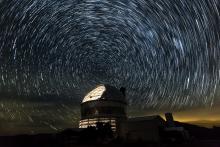Listen to today's episode of StarDate on the web the same day it airs in high-quality streaming audio without any extra ads or announcements. Choose a $8 one-month pass, or listen every day for a year for just $30.
You are here
On Alert
Astronomers and their telescopes get a lot of alerts — up to thousands per day. They report discoveries of some of the most impressive objects and events in the universe — and some of the most dangerous. The list includes many varieties of exploding stars, the mergers of heavy dead stars, nearby asteroids, and more. The alerts aren’t just for fun, though. They can trigger follow-up observations by astronomers and telescopes around the world.
The follow-up is needed to provide a complete picture of what’s going on. If astronomers discover a gamma-ray burst — one of the most powerful explosions in the universe — they want to see what’s happening with other “eyes” — telescopes that are sensitive to other wavelengths. That can tell them more about the blast and its aftermath, which helps them explain the explosion, its effects on its surroundings, and much more.
Many telescopes — both on the ground and in space — send alerts automatically. In some cases, astronomers look at the alerts and decide whether to turn their own telescopes toward the event. But some telescopes and networks of telescopes are designed to respond automatically.
A change in targets can disrupt scheduled observations, damaging other research. So systems have to be carefully designed — responding to the most important alerts, while leaving others for later.
Script by Damond Benningfield






